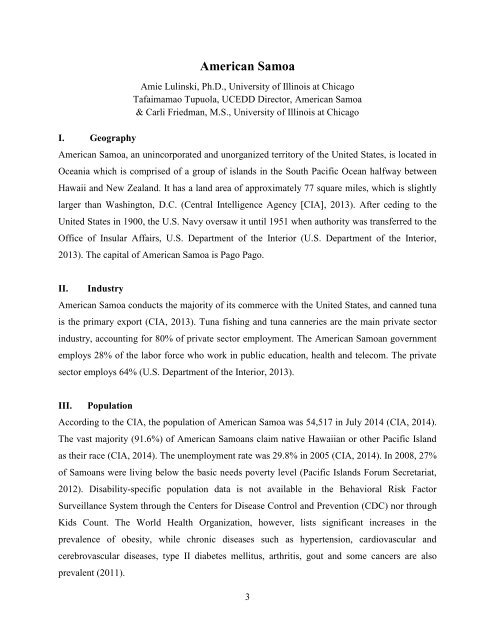Combined-Territories
Combined-Territories
Combined-Territories
You also want an ePaper? Increase the reach of your titles
YUMPU automatically turns print PDFs into web optimized ePapers that Google loves.
I. Geography<br />
American Samoa<br />
Amie Lulinski, Ph.D., University of Illinois at Chicago<br />
Tafaimamao Tupuola, UCEDD Director, American Samoa<br />
& Carli Friedman, M.S., University of Illinois at Chicago<br />
American Samoa, an unincorporated and unorganized territory of the United States, is located in<br />
Oceania which is comprised of a group of islands in the South Pacific Ocean halfway between<br />
Hawaii and New Zealand. It has a land area of approximately 77 square miles, which is slightly<br />
larger than Washington, D.C. (Central Intelligence Agency [CIA], 2013). After ceding to the<br />
United States in 1900, the U.S. Navy oversaw it until 1951 when authority was transferred to the<br />
Office of Insular Affairs, U.S. Department of the Interior (U.S. Department of the Interior,<br />
2013). The capital of American Samoa is Pago Pago.<br />
II. Industry<br />
American Samoa conducts the majority of its commerce with the United States, and canned tuna<br />
is the primary export (CIA, 2013). Tuna fishing and tuna canneries are the main private sector<br />
industry, accounting for 80% of private sector employment. The American Samoan government<br />
employs 28% of the labor force who work in public education, health and telecom. The private<br />
sector employs 64% (U.S. Department of the Interior, 2013).<br />
III. Population<br />
According to the CIA, the population of American Samoa was 54,517 in July 2014 (CIA, 2014).<br />
The vast majority (91.6%) of American Samoans claim native Hawaiian or other Pacific Island<br />
as their race (CIA, 2014). The unemployment rate was 29.8% in 2005 (CIA, 2014). In 2008, 27%<br />
of Samoans were living below the basic needs poverty level (Pacific Islands Forum Secretariat,<br />
2012). Disability-specific population data is not available in the Behavioral Risk Factor<br />
Surveillance System through the Centers for Disease Control and Prevention (CDC) nor through<br />
Kids Count. The World Health Organization, however, lists significant increases in the<br />
prevalence of obesity, while chronic diseases such as hypertension, cardiovascular and<br />
cerebrovascular diseases, type II diabetes mellitus, arthritis, gout and some cancers are also<br />
prevalent (2011).<br />
3



